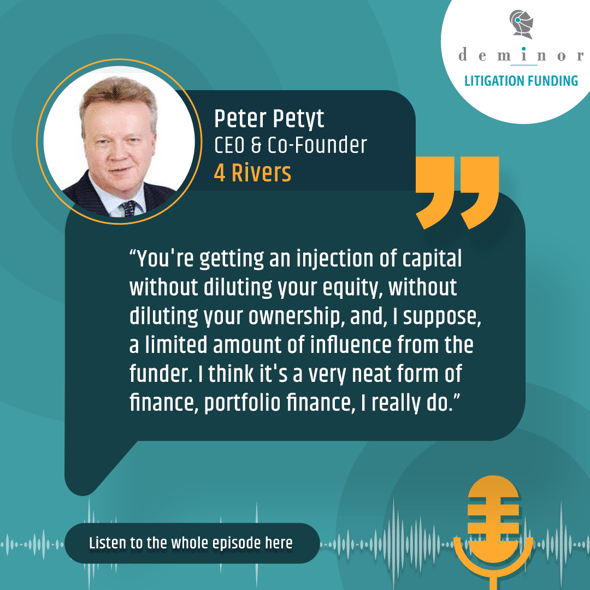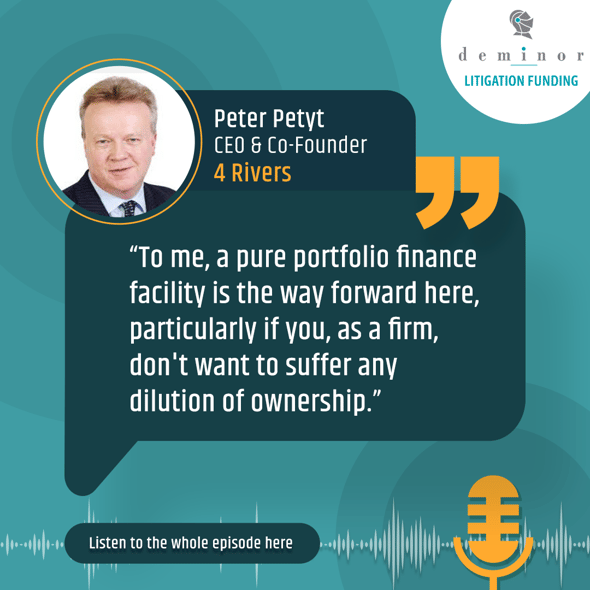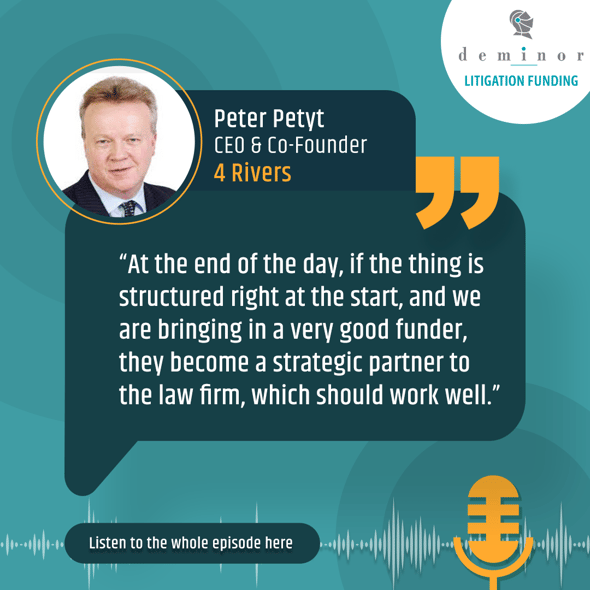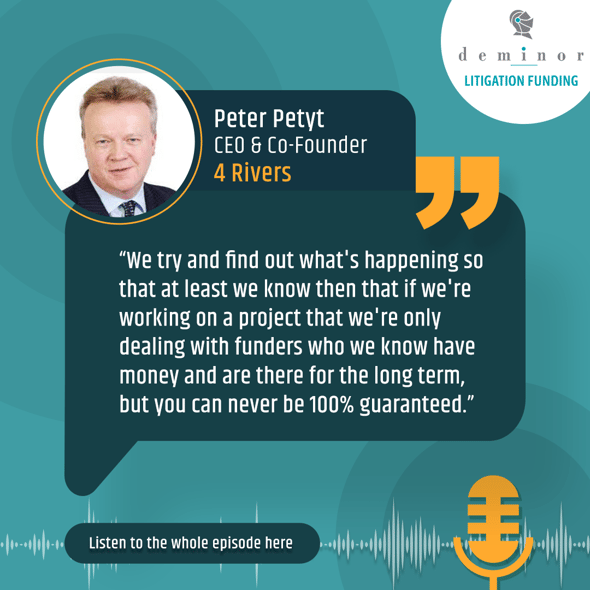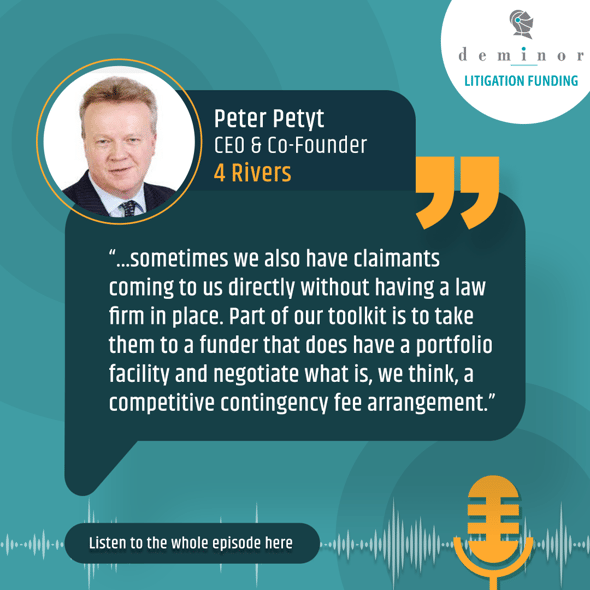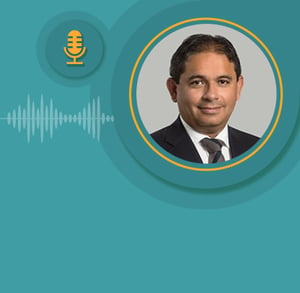In this podcast series, Emily O'Neill General Counsel UK for Deminor Litigation Funding, undertakes interviews with global professionals to discuss different aspects of litigation and litigation funding.
Deminor welcomes you to join this conversation as we summarise the key elements of the discussions between Emily O'Neill and these experts, as captured in the podcast transcripts below.
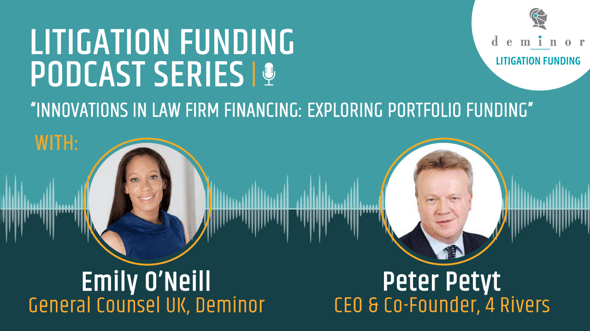
Podcast Preface:
Deminor General Counsel UK, Emily O'Neill (EON), speaks with Peter Petyt (PP), CEO and Co-Founder of 4 Rivers. He is currently undertaking part-time doctorate research on third-party funding at the University of Westminster.
In this interview with Emily, Peter discusses the increasing demand for law firm funding and shares his tips as to how law firms can present their funding request to best provide for a smooth approval process by funders.
Podcast Transcript:
EON – Today, I'm joined by Peter Petyt of 4 Rivers. We are going to talk about law firm funding, which we're seeing as an increasing investment class in the UK and elsewhere. Let's dive in with questions about the market and the different types of available structures. So welcome, Peter.
PP – Thank you, Emily. Delighted to be joining you.
EON – Brilliant. Let's start off at the beginning. We've seen the shift in the funding market, particularly in the UK, from a single case to a portfolio and now law firm-type funding opportunities. We can see that that's been more of a staple part of the US market for some time.
What is third-party funding for law firms? What does that look like? And why do you think there's been such a growth in the investment type recently?
PP – Yes. Thank you very much. Well, I suppose we have to look at the drivers behind this, which essentially are the same for whether it's a single-case or multi-case third-party funding. It's clear that clients are very keen on the law firm's ability to offer fee arrangements that require limited or no cash contribution, and they're basically success based. But, of course, law firms are businesses. They're very cautious about risking their own billable hours and third-party costs if any payment for these depends on an uncertain outcome. it's vital that law firms have adequate operating capital and working capital. We've seen that they can collapse if they become over-reliant on income from contingency fee cases. The need for cash flow while acting on a contingency basis is absolutely fundamental for survival. I think that's the driver.
Portfolio funding, which is the subject of the research I'm carrying out alongside my very busy day job, is essentially a form of finance provided for and secured against a bundle of cases that are cross-collateralised. That cross-collateralisation of the portfolio diversifies and reduces the funder's risk, enabling the funder to reduce its overall cost of capital, especially when compared to single-case financing, which we know is extremely expensive.
Once you've secured law firm portfolio finance against these estimated success fees, that allows a drawdown of working capital while the cases are in progress. It allows disbursements to be paid. Disbursements can be very significant in some cases, including the court and arbitration fees, the experts, the disclosure costs, et cetera. But it can also be used to fund other initiatives, such as acquisitions, recruitment, marketing, and IT investment. I think the crucial part of this is that portfolio funding allows the law firm to offer attractive contingency fee arrangements to its clients whilst maintaining a sensible level of working capital. Unlike bank finance or shareholder equity, it's a structured finance product aligned with the successes and failures of a case or a bundle of cases. And that's very attractive because it's non-recourse and it's nondilutive, unlike equity finance, which we'll talk about in a minute, I'm sure. There are some real attractions to this finance if it can be structured and secured properly.
EON – I agree. In the cases that we've looked at, law firms are quite appreciative of engaging with a financial source that actually understands their business model because I think the more traditional bank finance and other kinds of more traditional structures don't always understand the law firm model. There aren't many businesses that basically distribute all of their capital to their shareholders every year. I think funders are in quite a strong position despite litigation funding being a more expensive product than a traditional bank loan, but as you've said, there are other opportunities.
EON – How do you see funders viewing the additional ask? Not just in terms of pure funding for a portfolio, but if the law firm is looking for funding that they can deploy more broadly within their business. You mentioned other items like recruitment and marketing.
Do you see funders taking that risk, and does it economically make sense within the context of how funders traditionally get their return?
PP – I think at the end of the day, it comes down to the structure of the portfolio, how well diversified it is, and the quality of the cases within the portfolio. The better the portfolio quality, the more appetite the funder would have to invest within it because, at the end of the day, you, as the funder, of course, are there to make a return for yourselves and your stakeholders. And if there's a really good opportunity, why wouldn't you want to put more capital to work? At the end of the day, it comes down to the portfolio's quality and the cases within it.
And there are many other factors that our research is bringing up here. It has to do with the quality of the law firm itself, its track record, the quality of the fee earners and partners running the cases within the portfolio, and the general financial security of the firm. All of these are very important factors that would play into, I think, a funder's assessment of how much capital they wanted to put out. Certainly, we've seen portfolios that are good enough to invest in, but from a funder's point of view, to fund only the fees and costs associated with the cases themselves.
You've got a bundle of cases there, the law firm wants to draw down working capital to keep its lights on whilst running those cases on a contingency basis and paying the disbursements, such as experts. But perhaps the portfolio is not strong enough to support an additional investment by the funder, which would cover some of those areas that you mentioned, Emily. Again, it does come down to the strength of the portfolio and the cases within it, but certainly, the better portfolios that we've looked at and that we've helped advise on would merit an additional investment from the funder, if that's what the law firm wanted.

EON – Thinking about different funding sources for law firms that you talked about in your paper and the pattern of IPO for law firms and how that has tailed off. Why do you think that was, and how do you think law firms are looking to capitalise themselves in the current climate?
PP – I think that's a really interesting and really good question because it's, again, something that's coming up with the research we're doing. Well, you know, in the UK, law firms have been able to raise capital on the public stock exchange since 2012, when alternative business structures, or ABS as we know them, were brought into play. We've looked at a few of the flotations. There haven't been that many of them. We'd count Gateley, Gordon Dadds, Keystone, Rosenblatt, Knights and DWF. I might have missed a couple there, but that's mainly it.
On the face of it, a public listing allows law firms to raise cash, enabling them to fund contingency-style cases. And with Rosenblatt, it's quite interesting because they raised cash to actually set up an independent fund, although that's subsequently changed now, and Tets Ishikawa and his colleagues have taken that in a different direction. But there hasn't been a flotation that I'm aware of on the UK market since 2019. I know Mishcon were looking at doing an IPO in early 2023, which was pulled. I think they incurred about £12 million worth of aborted expenses - so it's not a cheap exercise either.
Only Gately and Keystone have higher share prices than their original listing, but there have also been casualties. So, it's clearly not necessarily a very positive trend. The reasons for that, I think, are multifarious, and I think sometimes it's very difficult to persuade an entity such as a law firm to go that way because they're very used to running the business themselves. They have a lot of autonomy in how they do that, to being able to draw down partner distributions on a yearly basis. If the firm has a really good year, they cash in and look at it on that basis, rather than with a flotation where you will have to rein in that yearly remuneration and answer to external shareholders and stakeholders. And, okay, yes, you're building capital value for the future in theory, but you're not necessarily sure when you can cash that in. Clearly, when law firms float, there are restrictions on when the partners can actually cash in those shares. And I think it's such an unusual and new concept for them to look at that many don't really buy it.
At the moment, if you look at the track record and the share prices, there's not a convincing trend that shows that you will develop that much value beyond what you would do under a traditional structure. I think it's certainly unproven. I would, however, say that there's plenty of time for this to change. It's pretty nascent still, but so far, I don't think the evidence is particularly persuasive. What happens in other places like the US now that the regulatory environment is changing here is a completely different issue. We can talk about that as well because certain states in the US are now open to external ownership of law firms, but we haven't seen a public flotation, and I'm not aware that there's a plan to do that anytime soon. The UK is an interesting laboratory for this, and I would say that the results are not particularly convincing to date.
EON – I agree with that. I've discussed why and why not to float with various law firms. One of the arguments around why not to float is a future-looking one. Maybe you can secure the firm with the capital, but are you securing the people? The partners at the flotation will have a big payday eventually, but those who are coming up behind them will not benefit from the same structure and maybe remuneration that those partners who were there at the IPO had. With a minority of firms actually going through this, it may make them less attractive to up-and-coming junior partners. I think one of the arguments against that I've heard here is exactly that: you're not really safeguarding your future talent pipeline.
PP – I think that's absolutely right. I think there's a lot of uncertainty around it. If there were a track record of 20 years’ worth of value creation, I'm sure people would feel a bit more comfortable about it, but there isn't. And I think until you get that, there will be scepticism and reluctance for this to happen too often.

EON – Before we talk about litigation funding for law firms, you mentioned the US and regulatory changes there, enabling other ownership of firms and profit sharing with others in some US states.
We’ve seen case structuring to enable that to happen, and some firms may potentially move to Arizona, Utah and the States, which I think are more attractive for that structure. Perhaps you could explain from your side what you see on the ground?
PP – That’s also very nascent. We’re in the very early stages of all this happening. Arizona and Utah are the outliers here. They’re the ones that have gone out on a limb and said, right, yes, we will permit external ownership of law firms. Inevitably, because of that, you’ve seen more tech-type law, tech legal services firms as well, who are going into Arizona and Utah, which I think has a sandbox, as they call it, to set up and establish these kinds of firms. Allowing themselves to attract non-lawyer ownership, whether through capital financial investors coming in, such as a private equity house or a family office, or even an individual, but also bringing in non-lawyers as owners of the firm who may have completely different skill sets. You see CEOs coming in, CFOs, attracting people with different skill sets who are nonetheless incredibly important to run a modern organisation and bring in those important non-legal skills. There's been quite an influx of these instances in Arizona and Utah.
Other states have talked about it. California, where I'm currently based, is looking at it, but has knocked it back a few times. Florida is the same. And I think one of the law professors over here, Victoria Sahani, described the US as a laboratory with 50 different laboratories, and they're all a bit different. All of the states have different regulations. I know some funders over here are very concerned about investing in portfolios in some states because of the potential issue of fee-sharing rules. So, you've got certain states over here that are much more resistant to these structures than others.
I think the UK definitely started the trend in 2012 with the introduction of the ABS model, and so far, I think the results of that are somewhat uncertain and variable over here. I just don't think that there is enough of a track record at the moment to show what's going on. However, if you do want to set something in the US and bring in external owners and non-lawyer owners of firms, these are the places to do it – Arizona and Utah; they're the ones that have opened the doors and said: ‘Yes, we want to try and make this work’. I think if we spoke in a few years’ time, there'd be more evidence to talk about, but at the moment, it's very nascent.

EON – Do you think the opening up of fee-sharing or third-party ownership of law firms will lead to vertical integration in the market?
In the UK, we've seen funders acquiring shares or law firms; there's vertical integration there, the shareholder investment in the law firm and then using that law firm partly for business diligence but partly as a source of cases to fund. Do you think that type of structure could open up in the US?
PP – Yes, I think it's entirely possible. I think that at the end of the day if you're going to go for vertical integration, you're probably looking at synergies and cross-referral opportunities and other benefits like that. I guess the bigger question is probably on a litigation funder having an equity stake in a law firm and what compliance and potential conflicts does that bring up?
The obvious example to bring about this is when Burford took a stake in PCB Litigation in the UK; they took an equity stake and provided funding for a portfolio of cases. Burford has been very vocal about this, saying, ‘This is a real opportunity for law firms to benefit from capital from funders, as well as the expertise and experience you get by working with a funder generally.’ And I think that's absolutely right. But equally, Burford were fairly vocal about the fact that the SRA were quite difficult about that. They got the deal through in the end, but it wasn't easy by all accounts. I think this continual issue that you have with conflicts and whether a funder should be influencing the decisions of a law firm and the strategy of a law firm on individual cases is a perennial issue. As we all know, although champerty and maintenance may be a relic of the past, its influence is still there. And Deminor, as well as other litigation funders that we work with, are very careful about how their funding agreements are structured so that the funder is not seen to be having an influence on the settlement strategy of the case or whatever.
With the involvement of a funder, there is a line that can be crossed at a point, and taking equity ownership is probably pushing that line a bit because, as an equity owner, you will want to have some kind of influence. That's why people bring in private equity houses and venture capitalists and people like this, because yes, they want the money, but they're not going to get that money without some participation from the investor, whether that's a board seat or something else. If you look at the way that these investments are structured, there are usually rights granted to that investor that allows it to get more involved if things go wrong.
I think the bigger ethical issue here and again in the States (varying from state to state) would be exactly how much do you allow the investors to get involved? But at the end of the day, if an external owner can come in, whether that's a litigation funder or just a private equity house or something like that, that should enable capital to allow the business to grow and prosper. And access to capital is the lifeblood of any successful business.
With my corporate finance background, I'm all in favour of allowing external investment. The question is, I think with equity ownership, you're getting dilution of equity. The joy of a portfolio finance facility is that it's non-dilutive – everyone's aligned, and everyone wants success within that portfolio. Yes, the law firm ultimately would be giving up part of its success fees, but as I say, it's non-dilutive capital. You're getting an injection of capital without diluting your equity, without diluting your ownership, and, I suppose, a limited amount of influence from the funder. I think it's a very neat form of finance, portfolio finance, I really do. The issues are perhaps more practical: getting a portfolio or structuring a portfolio that works so it's attractive from a funder's point of view and then being able to work with the law firm to make that happen. We know this because we see it often. There are lots of frustrations, often between funders and law firms, because this is quite hard work. The fact that you have lots of different fee earners within firms that don't necessarily know what each other is doing. There may be the opportunity to structure a fantastic portfolio there, but someone's got to get into the weeds and work out how to do that, which is, I hope, where we come in.

EON – We've seen in the UK that law firms are getting a bit more sophisticated around funding and putting their own internal funding boards in place, where they have a level of coordination between the different fee earners and the different teams. But I agree; I think a portfolio of diversified assets is much more attractive to a funder than a set of different individual cases from the same team or the same type of case. I'm balancing that against portfolios of the same claim type: more consumer cases where it's easier to do due diligence and look at the track record.
Do you have any tips or ways law firms can approach structuring a portfolio or how to start that conversation with a funder? Obviously, having somebody to project manage that is very helpful, but where do firms start with that?
PP – Your point about some firms bringing in resources and having their own litigation funding departments is very interesting. I think it does add a lot of expertise to a law firm's ability to bring in funding. But of course, that's only going to be for the bigger firms, who can do that. What we see as a potentially much larger market for what we do is the medium-sized firms and the boutiques that simply don't have the wherewithal to bring those resources in-house. They need to use someone, hopefully like us, to help them, to help them put the portfolio together.
The first thing we do is go in and do a bit of a deep dive into the firm. Look at the firm's history, the fee earners, and the expertise and the focus, just to make sure that we feel that the firm will be credible in front of a funder. That's a very important first step. And then dive a bit deeper into the actual case types. Often, we're looking at a spreadsheet to start with, which has a list of cases that have contingency fees attached to them.
Then, drilling down and looking at what those different types of cases are. How well diversified are they? You have four cases; is one of them a patent case? Is one of them a commercial case? Is one of them an insolvency case? How much diversification is there in the potential portfolio? Do the numbers work? One has to look at the base values of the contingency fees as opposed to the maximum values. Will it work on that basis? Will the funder be able to take comfort from that? And then again, look at the uses of finance. How much does the law firm actually need? What's it looking for in terms of working capital to run those cases? Is all the capital required to run the cases, or is there an additional requirement to fund other initiatives? There needs to be a cash flow model put in place to show how this will all pan out and show the funder what returns they'll get over a period of time. There are other more practical issues. If you have more than one fee earner's case in a portfolio, and one of them goes wrong, is that going to prejudice in any way, the partner whose cases go right? These kinds of practical, on-the-ground issues are very important because a law firm is not going to want to do this unless all of those questions can be addressed and answered.
That’s the role that we tend to play. It's quite a deep dive, quite an involved project management role. But our experience shows that if that's not done, these portfolios rarely happen – I think it's an important role.
EON – Your point about how much the firm needs is an important one. In the cases that we've looked at, the firm often overestimates their funding need. And actually, there can be a way to invest and maybe recycle within a portfolio so that the drawdown is not so significant. Then you get economies of scale in terms of pricing versus a pure investment drawdown, repayment, and fresh capital type structure. Diversification is important as well - we prefer a diversified portfolio not tied to any particular claim type. Firms, when looking at putting together portfolios, will be more attractive if they can do that. As you said, true diversification in claim size: one massive case and three tiny ones are still not diversified portfolios. There's a lot to think about.

EON – We've talked about equity investment, and we've talked about portfolio investments. Are they the main structures? Are there hybrids that you see for funders to invest in law firms?
PP – Well, it's interesting because the other structure that seems to have been deployed and is talked about quite a lot, which I am quite critical of, being very honest, is what's sometimes known as a pact or a best friend relationship. In these relationships, this is where the law firm partners with a preferred funder, which finances the law firm, fees, and expenses, on cases where the law firm's clients request it and the law firm and funder agree the case is worthwhile. There's been a few of those.
Wilkie Farr & Gallagher did a big facility with Longford in 2021. Harbour has done one with Mishcon De Reya; LCM did one with DLA. I have to say that I think that these are, as much as anything, marketing exercises because, at the end of the day, they’re not portfolios. If funding is secured, the client still pays for it on a single-case basis. It’s for the client’s account, not for the law firm. So, you’re not getting any benefits of cross-collateralisation or diversification.
The worst part is that if the preferred funder decides not to fund the case, what chance does that give you in the market of getting a case funded by another funder? Because the other funder will naturally be worried that the preferred funder turned it down. I don’t think there’s any evidence, certainly not anything that we’ve come across, that suggests that there’s a particular advantage in terms of speed of getting something funded or, indeed, of pricing. I think the research will bring this out more, and perhaps there will be exceptions to what I’ve just said, but I think that you have to be very careful in these things, and the conflicts that potentially can arise are not insignificant.
It isn't a portfolio structure, but it's talked about a lot, so we have to address it and discuss it. But I do think otherwise you’re looking at either pure equity investment from either a funder or an external investor, such as a private equity house, or as I say, a portfolio finance facility, which is where I think that potentially you can really get the benefits of this.
If you look at the publicly announced portfolio facilities, and they're only the ones that have been announced publicly, there may well be more, it's clear that they are genuine portfolio finance facilities. If it's a UK firm, you look at Companies House, you can see that charges are being registered. It's a proper portfolio finance debt facility, and they're going to be the structures that I think are most often deployed going forward in whatever jurisdiction you're looking at, to be honest. To me, a pure portfolio finance facility is the way forward here, particularly if you, as a firm, don't want to suffer any dilution of ownership.
EON – I guess with all funding structures, it comes down to appetite for the different structures. We've seen, and we've had discussions with, firms who have entered into the pact-type relationships, and we've seen cases coming from those firms. You’re right; that's the first question I'm asking - why wasn't it funded by the preferred funder? I have also seen that those kinds of pact funds where the law firm partners have also invested money into the fund make it difficult sometimes to deploy capital because the risk appetite of a law firm partner is not the same as that of a litigation funder, and so structuring those deals can be quite difficult.

EON – We've talked about structures, and we've talked about the benefits of using third-party funding for law firm finance.
What about the risks to the law firm of using funded capital? What can those be?
PP – I think at the end of the day, that's actually quite a difficult question to answer because being an advisor on third-party funding and working with high-quality funders such as yourself, Emily, we're doing it because we think that actually, the risks from a law firm's point of view are quite small. We're helping advise them on raising capital that's allowing them to grow and prosper within their businesses. Therefore, we will only be talking with investors or funds who we believe are credible, have the right expertise and experience, and can add more value apart from just the money.
We've seen it before. If you bring a funder in, you'll get money, but you'll get many years of experience. You guys, as funders, see cases every day, you really understand what's going on in the market, and you can bring a lot of added value as essentially a strategic advisor, apart from just putting the money in. I would say that again, from a portfolio funding point of view, just looking at that, involving a high-class, credible funder is a big value add.
Now, can it go wrong? Of course, any finance facility can go wrong. It will mainly go wrong if expectations haven't been managed at the beginning. A really simplistic comment is often that you agree on a facility at the beginning, and then there's a big win, and they have to hand over a lot of that win to the funder who's backed them. At that point, I think that partners in firms and law firm management must be properly managed, and their expectations must be managed. That's, again, something we do quite a lot of. We're saying, look, everyone's aligned here. But you do know if you do get a big win, that a chunk of that's going to have to be handed over to the people that backed you.
I also think that managing individual partners within portfolios is important because, as I said earlier, if one of their cases goes wrong, does the partner whose case goes right then suffer as a result of the one that's gone wrong? Again, managing that and making sure the law firm has a structure in place to handle that so that there's no harm done to the successful partner as a result of that is quite important. There are practical issues that need to be managed there. At the end of the day, if the thing is structured right at the start, and we are bringing in a very good funder, they become a strategic partner to the law firm, which should work well.
Things can go wrong. Yes, people can fall out. Law firms change. I mean, partners leave sometimes and move on. How much effect will that have on the ongoing portfolio? Yes, that has to be looked at as well. That's a risk. Difficult times out there at the moment, challenging economic times. Law firms can suffer for other reasons. Is that going to, in any way, be an issue going forward, the financial stability of the law firm? All these things need to be considered, but hopefully, it's set up as a successful partnership, and indeed, the funder then becomes a real ally if times do become challenging.
EON – There are two things there that I wanted to pick up on. I think a credible funder is key, and having somebody who can navigate the market and understand who the credible funders are is really important. We've seen reports in the press recently around deals that have been signed, and the funder didn't have the capital to pay the drawdowns, and from within the market, that's really disappointing.
We're a member of the Association of Litigation Funders, and we have to meet capital adequacy requirements to become a member of that organisation. But I think there are, I'm going to call them ‘broker funders’ in the market who operate in a different way. Understanding how the funders are capitalised and navigating law firms to the best fit is a really helpful contribution to structuring that deal because law firms are not going to know.
The second thing I was going to pick up on is the adding value. Since I joined Deminor, I've seen more cases in a year than I have seen in my entire career. Talking to different firms, different claim types, different strategies. So funders, we do have a lot of knowledge, but in certain jurisdictions, from a regulatory point of view, you have to be a passive funder, and if you've gone forward and backed the case, then you're bringing all of that knowledge to the table in supporting the claim that's being put together by the law firm.

EON – I think one risk for a funder in investing in a law firm, particularly if it's an equity investment, is what the exit looks like.
How do we exit?
PP – Absolutely. That means that there's going to need to be an anticipated transaction down the line, which is what private equity does. Most of the time, it's investing because of the exit. Yes, there may be a yield before then in terms of dividends or whatever, but normally, it's predicated on the exit. That's a really good point. Yes, as I say, we just haven't seen much of it recently or to date. And I suppose it's then going to come down to, well, okay, what are the exit opportunities? Is it a trade sale? Is it an IPO, or is it some other buyout? I think as the market matures, that will happen more often, but it's very early stages at the moment.
To go back to what you were saying about credible funders. This is an important area and something that we police as carefully as possible. For obvious reasons, many funders have lots of offshore structures from a tax point of view, so the transparency on what capital they have available is quite limited. So often, you're using other means to judge whether you think a funder is credible, and that can be, as much as anything, just keeping your ears to the ground and finding out what's happening, who's doing what.
If you get big exits from funders, if lots of teams leave, I mean, that happened last year. Five people from one funder went to another one; it's not a particularly good sign from the funder that's being exited. And you're absolutely right; there are funders out there who once had capital who now don't have capital but are still holding themselves out to be a principal funder. As I say, we talk to lots of people every day. We try and find out what's happening so that at least we know then that if we're working on a project that we're only dealing with funders who we know have money and are there for the long term, but you can never be 100% guaranteed.
EON – Do you think that's an issue, the trust issue? We're a balance sheet funder with onshore capital, so we're a bit more atypical in the London market, but we've been encouraged to set up offshore structures, particularly by insurers who prefer that, but we have declined.
EON – From the discussions you've had with law firms, does that come into their decision as to trusting the funder and understanding the structure of the funder before they enter into a business partnership with that organisation?
PP – Yes, I think it is. And to a certain extent, they will also rely on our judgement of that. We are not going to be taking a client to a funder unless we believe that the funder is credible, well-financed and can, as I say, bring other value to the table.
Of course, there are three funders out there who are publicly quoted, so you've got a bit more visibility with them. But with the vast majority of funders, you haven't got that visibility. In the UK, you do have more visibility because of Companies' House filings of accounts, but even that won't tell you the whole story because there will often be offshore structures where the capital might sit. It is difficult to be conclusive about it. And that's why I think it almost comes down to a face-value type judgment.
As I say, we're talking with people every day; we swap notes in a very friendly way. And there have been some interesting conclusions that have been drawn from those conversations. I mean, we have found out things that perhaps weren't publicly known that are quite important. I think it's a very important issue.
EON – Just to finish, it would be good to pick up on a point that you made earlier around the ethics of litigation and funders investing in law firms – the conflict of interest point.

EON – Are there going to be conflicts between what the funder wants out of the relationship and what the law firm is looking for?
Are the lawyers within the firm meeting their professional obligations to the client to secure the best deal?
What kinds of ethical issues can arise in this situation, and how can law firms and funders safeguard themselves?
PP – This is where I think it's important that you're looking at the law firm essentially offering a contingency fee to its client because then, essentially, the finance is wrapped up in that contingency fee. So, the law firm says, ‘Okay, I'm going to take on this case, and here's my contingency fee structure; or I get X-percent if it settles before this date, or Y-percent if it goes to trial.’ And that's all wrapped up in one contingency fee: it's a very elegant, simple solution. It doesn't mean you have a law firm retainer agreement, a funding agreement, and potentially an insurance agreement – rather, everything is wrapped up in one. That way, the client is going to take advice on whether they want to accept the contingency fee arrangement or not. But if they're happy to, then that's it, and whatever arrangements the funder has with a litigation funder are in the background, they potentially have no impact on the relationship between the law firm and the client. That's why a portfolio facility works so well because you remove those conflicts.
As we were saying about the pact relationships, a law firm says, ‘You should go to our preferred funder, but the cost of that finance is going to be for your account.’ Well, that's potentially an issue, because the law firm is trying to push them towards a source of finance which may not be in their best interest. That's why I think the pact relationship is flawed. I think it comes down to whether the law firm is taking the finance onto its balance sheet. Or will the claimant ultimately have to take out a separate finance agreement? That's where the conflict issue potentially arises.
I don't have a problem if a funder puts an equity investment into a firm and adds on a portfolio facility, but then the firm offers a contingency-style arrangement to its client; I don't think there's an issue. I think that's actually quite an elegant solution and one that we encourage because sometimes we also have claimants coming to us directly without having a law firm in place. Part of our toolkit is to take them to a funder that does have a portfolio facility and negotiate what is, we think, a competitive contingency fee arrangement.
EON – Brilliant. Thanks very much, Peter. That's been a wide-ranging and interesting conversation.
PP – I've enjoyed it very much. Emily, thank you for allowing me to be on it.
EON – Perfect. And thanks, everyone, for joining. Please join our next episode to look at other aspects of litigation funding.
Litigation Funding Podcast Series - Next Steps and Further Information:
Thanks for joining Deminor's Litigation Funding Podcast Series as we dive deep into core topics in funding litigation.
Keep an eye out for our upcoming conversations as Deminor General Counsel UK, Emily O'Neill, speaks with several more experts to get their insights into different aspects of litigation funding.
If you would like to connect with either Emily or Peter on LinkedIn, please click on the links below:
Emily O'Neill – Deminor General Counsel UK and Global IP lead
Peter Petyt – CEO and Co-Founder of 4 Rivers
***
Further Reading:
- https://www.deminor.com/en/case-studies/co-funder-proposes-sharing-of-litigation-funding-risk-to-leverage-deminors-in-house-due-diligence-capability
- https://www.deminor.com/en/case-studies/financing-assertion-of-patents-protecting-manufacturing-processes
- https://www.deminor.com/en/case-studies/telecoms-patent-assertion-multi-jurisdictional-campaigns
- https://www.deminor.com/en/case-studies/canadian-innovative-start-up-preparing-for-a-david-v-goliath-litigation-funding-battle
- https://www.deminor.com/en/case-studies/whats-the-risk-assessing-the-risk-of-counter-assertion-by-the-defendant-in-patent-litigation
- https://www.deminor.com/en/case-studies/overstepping-the-mark-litigation-funding-trade-mark-infringement
- https://www.deminor.com/en/case-studies/lights-camera-action-recovering-damages-for-infringement-of-rights-in-a-short-film
- https://www.deminor.com/en/case-studies/recovering-damages-for-stolen-software-through-litigation-funding
- https://www.deminor.com/en/case-studies/funding-in-the-pharma-sector-/-investing-in-a-case-where-litigation-is-already-ongoing


